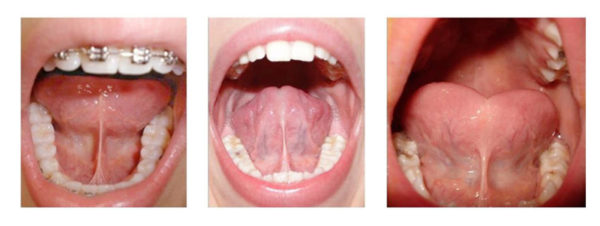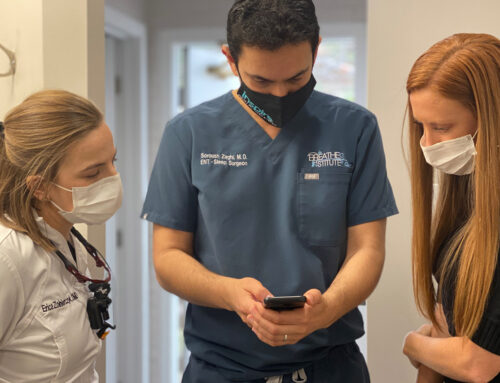A posterior tongue-tie is a relatively new concept to many people in the dental field but I’m seeing a lot of patients with posterior tongue-ties in my practice, so I thought I’d go into some detail about this condition.
We’ve been hearing a lot about tongue-ties lately as modern medicine starts to recognize the negative health effects of a tongue-tie, but did you know that there are two types?
Anterior tongue-ties are obvious. This is the kind of tongue-tie that’s most easily diagnosed and treated. We can see right away that the underside of the tongue is connected too tightly to the floor of the mouth, and that the range of motion is restricted.
Here are some examples of anterior tongue-ties (Image from CEFAC).

Posterior tongue-ties are quite different because they don’t look obvious at first glance. The back part of the tongue is restricted rather than the front portion of the tongue, and the restriction is totally different.
Here are some examples of people who actually have posterior tongue-ties. You wouldn’t think they were tongue-tied based on how much they can extend their tongue.

Why Does A Tongue-Tie Matter?
We all have a lingual frenum (or frenulum). This is the line of tissue that runs under the tongue that connects the tongue to the floor of the mouth. In some people, as I mentioned above, it’s restricted, which is why a tongue-tie is also known as a restricted lingual frenum, and sometimes as tethered oral tissue. This restriction can prevent the tongue from moving correctly or from resting in the right place. This can in turn cause a number of symptoms and functional limitations depending on how bad it is.
Tongue position is really important when it comes to our overall health! The tongue should fill up the entire roof of the mouth from front to back. When it’s in this position, it provides a support structure for the upper jaw. When the tongue is in the right place, teeth grow in straighter and the face develops optimally. But a tongue-tie means that the tongue is literally unable to reach the palate all the way, if at all. So it rests in the bottom of your mouth, which is dysfunctional.
People who are tongue-tied often mouth breathe. This leads to a wide range of myofunctional problems and symptoms. Chronic jaw pain, sleep apnea, facial pain, headaches, and clenching and grinding, along with dental and orthodontic issues are common in people with tongue-ties. Research shows that tongue-tied children are at higher risk to develop sleep apnea and airway issues, and their facial and cranial development is also impacted.
Dealing With A Posterior Tongue-Tie
Posterior tongue-ties can be difficult to diagnose because they can be so subtle.
As I explain in the video below, people with this type of tie can often stick their tongue out a long way, and they can sometimes get the front (or even all) of their tongue to rest on the top of the mouth. It’s easy to take a look at them and assume that there’s no restriction, and therefore no tie. But what’s actually happening is that there are a lot of other muscles compensating for the restriction. For example, the floor of the mouth might be lifting up to allow the tongue to move to the palate.
These muscular compensations can cause pain and tension through the entire orofacial complex and the cranium and neck. This can lead to clenching, grinding, TMJ problems, postural problems, as well as sleep apnea or other sleep disordered breathing conditions. Babies with a posterior tongue-tie may also have difficulty breast-feeding.
Without the correct diagnosis, patients are often left without a way to effectively address their symptoms. To make matters worse, there aren’t too many doctors or dentists who are familiar with the symptoms and effects of a posterior tongue-tie, or who know how to release them properly. The release procedure is still simple but it has to be done a certain way to get the best possible results and prevent reattachment.
An evaluation by an oral myofunctional therapist who’s very experienced with posterior tongue-ties is the first step to addressing this condition. There are signs and symptoms that are easily missed, so experience is critical. Myofunctional therapy is a key component to dealing with any tongue-tie. The pre and post-procedure exercises need to be carefully chosen to work specifically on the posterior restriction and the associated muscular weaknesses, compensations and dysfunctions.
With the right approach, a posterior tongue-tie can be easily treated, and the oral and facial muscles can be retrained for a lifetime of good health.
Tongue-Tie Resources
For more information on tongue-ties, you can take a look at the following resources:
My tongue-tie article on Ask The Dentist.
My infographic about tongue-ties.
My interview with Stacy Fletcher about tongue-ties and epigenetics. Stacy is a myofunctional therapist who’s studied tongue-ties in detail, including the underlying MTHFR gene mutation and the other associated epigenetic factors that actually cause this condition.
The tongue-tie videos on my YouTube channel.
Dr. Soroush Zaghi is a pioneer in diagnosing and treating posterior tongue-ties. His website is filled with great information!




